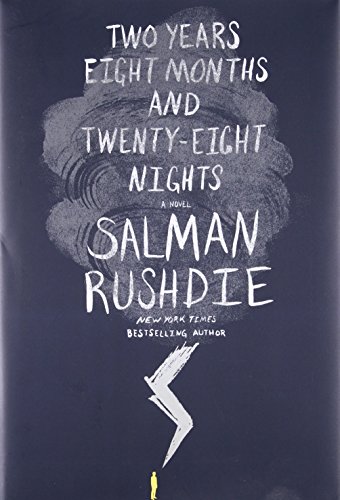Two Years Eight Months and Twenty-Eight Nights: A Novel

“a morality tale, a love story, and a contemporary fable that depicts the battle between good and evil.”
A long-standing feud between two dead philosophers who argue about reason, faith, and God from beyond the grave; capricious jinns who terrorize the upper atmosphere (and one who falls in love with a human); earthly mortals who become magically imbued with jinn-like powers; and satirico-comical reflections on contemporary life—and what it has become in an age of terror and violence—combine seamlessly in Salman Rushdie’s latest work of fiction Two Years Eight Months and Twenty-Eight Nights. Coming three years after the publication of Rushdie’s acclaimed memoir Joseph Anton, Two Years Eight Months and Twenty-Eight Nights—Rushdie’s first novel for adults in six years—once again establishes this renowned author as a master of the magical-realist genre.
The story begins in the twelfth century CE, when a female jinn, or jinnia, the “Lightning Princess” Dunia, leaves her world of Peristan (or Fairyland) for the earthly world of the philosopher Ibn Rushd, with whom she falls in love and bears a whole dynasty of children, known as the Duniazát (Dunia’s tribe). The Duniazát have one common feature that marks them out as members of the tribe: they do not have earlobes.
Ibn Rushd eventually dies and Dunia leaves this world, only to return during the time of the “strangenesses,” which last for two years, eight months and twenty-eight nights (i.e., one thousand and one nights). The “strangenesses” mark a dark time on Earth as well as in Peristan and culminate in a battle to the death among the four chief jinn, or Grand Ifrits: Zumurrud Shah, Zabardast, Ra’im Blood Drinker, and Shining Ruby.
Embedded in this main narrative are numerous other stories that are interwoven with one another; as the philosopher Ibn Rushd reflects, “. . . stories were enfolded within other stories and contained, folded within themselves, yet other stories, so that the story became a true mirror of life . . . in which all our stories contain the stories of others and are themselves contained within the larger, grander narratives, the histories of our families, or homelands, or beliefs.”
And so we also have the story of the bitter rivalry between the two philosophers, Ibn Rushd and Ghazali of Tus, who argue over Reason versus Faith, this theme becoming an allegory that runs through the novel and a driving force behind it.
There is also the story of the earlobe-less descendants of Dunia: Geronimo Manezes, a gardener who hails from Mumbai and one day wakes up to find that his body no longer touches the ground when he walks; Jimmy Kapoor of Queens, who learns that he, like Geronimo, is not just “a brown dude in America” but also “half fucking goblin too”; self-hating Teresa Saca, from whose fingertips “white forking voltage” poured out; and a host of other memorable figures.
Anchoring these wildly improbably narratives in contemporary reality are the narrator’s observations about the disturbed times in which we live, where the wacky wiles of the jinn on Earth— “the growing interference of the jinn in the daily life of the world”—and in Peristan can be offered as explanations for everything from terrorism to gun violence to climate change: “The influence of the jinn was everywhere, but in those early days, before they fully revealed themselves, many of our ancestors did not see their hidden hands at work, in the collapse of a nuclear reactor, the gang rape of a young woman, or an avalanche.”
Yet it is questionable whether the jinn are entirely responsible for the mayhem on Earth, or whether our own civilization is to blame: in another digression, the narrator satirically comments on gun violence in America: “She was familiar with a certain type of American crazy. Gun crazy was normal to her, shooting-kids-at-school or putting-on-a-Joker-mask-and-mowing-people-down-in-a-mall or just plain murdering-your-mom-at-breakfast crazy, Second Amendment crazy, that was just the everyday crazy that kept going down and there was nothing you could do about it if you loved freedom.” However, he continues, the crazy perpetuated by the invisible jinns during the “strangenesses” was “different. It felt 9/11 crazy: foreign, evil.”
Much of the action on Earth takes place in the United States, in New York City; even President Obama is not spared Rushdie’s political allegory, as the narrator reflects on all that is wrong in the world and why. In the wake of terror, the president of America is, somewhat sadly, characterized as “a president of empty words. As many of them are, as they all have been, for so very, very long. But we had expected better of him.”
Reason and unreason, coherence and incoherence, order and chaos, fantasy and reality: all of these dualities combine to yield a fast-paced, breathless tale that is wild, whimsical, and strange, yet not without its moments of comedy, a type of burlesque that is quintessentially Rushdie, such as the scene where Dunia, who is on a flying carpet, gets lost while searching for Geronimo Manezes, and exclaims in disgust: “This is why I prefer not to use carpets . . . Their blasted positioning system is always going wrong.”
In Two Years Eight Months and Twenty-Eight Nights, Rushdie conjures up a world in which humans have jinn-like powers and jinn are human, even lustful, unable to get their fill of sex as they war for power and supremacy among themselves and over Earth. The separation of jinn from Fairyland and of humans from Earth is a larger metaphor for the displacement and detachment from place that is characteristic of these chaotic times of migrancy, for the separation of reason from truth, for the corruption of language itself. This dark tale with its light moments shines a light on the ridiculous machinations of contemporary politicians all over the world and on all-too-human foibles. It is a morality tale, a love story, and a contemporary fable that depicts the battle between good and evil.